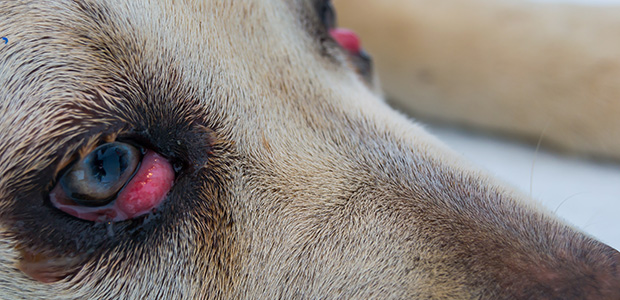Cherry eye in dogs: causes, symptoms and treatments
Cherry eye is reasonably common, especially in brachycephalic dog breeds.
For owners, it can be a scary sight to behold, and it’s important to know what to do if your dog is suffering from cherry eye.
Let’s take a closer look at cherry eye in dogs – what it is, how to spot it, which dogs are more susceptible than others and most importantly, the treatments needed.
Cherry eye – what is it, exactly?
Cherry eye is a pink mass that appears in the corner of a dog’s eye. It’s caused by prolapse of the tear gland in the third eyelid.
Cherry eye isn’t pleasant to look at. It’s not a very painful condition but the swelling can become inflamed and irritated, so it’s important to seek veterinary attention if your dog is suffering from it.
Are there any symptoms?
Just the pink mass itself, which will protrude from the edge of your dog’s eye nearest to their nose. Your dog may not seem uncomfortable until their cherry eye has become advanced and led to other problems, so it’s important to check their eyes regularly for signs of swelling, infection or other illnesses.
Cherry eye in Bulldogs: why are some breeds more prone to it than others?
Prolapse of the tear gland is a lot more common in brachycephalic breeds, such as British Bulldogs, French Bulldogs and Pugs, than other breeds. This is because their squished facial anatomy and shallow eye sockets cause the eyes to protrude from the skull. In turn, the less room the eyeball has, the more pressure it places on the tear duct and third eyelid, and the more likely it is to prolapse.
Read more: a ‘brachycephalic’ breed is any breed with a short snout or ‘squashed’ face. Because of their facial anatomy, they’re susceptible to many health conditions, especially breathing problems.

Treating cherry eye in dogs
Treatment will depend on how serious the condition is, and whether your dog has had it before or is susceptible to it.
When you bring your dog to the vet to be examined, they’ll decide on an appropriate course of action based on the individual case. Surgery is often needed to treat cherry eye and replace the prolapsed gland. Medication or a course of steroids may be used in the short term. The presence of the mass can be intermittent and in very rare cases, cherry eye can go away of its own accord.
The important thing is to get the condition checked out before it’s allowed to get worse.
How much does cherry eye surgery cost?
This will depend on your dog’s condition, your veterinary practice and whether or not your pet is insured.
Need more info?
To find out more about cherry eye in dogs, dogs’ eye health or brachycephalic breeds, have a chat with your local vet.
Find your nearest vet using our Find a Vet page, or speak to a vet online using Online Vets.

